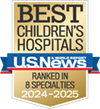
How To: Identifying a Brain Injury
Posted: February 28, 2012When your child sustains a brain injury, it can be frightening. Nearly 5.3 million Americans have a disability resulting from a traumatic brain injury (TBI), and for children, TBIs are the most frequent cause of death and disability, according to the Tennessee Disability Coalition.
Children who have sustained a TBI may have unique needs. If your child comes through Le Bonheur's Emergency Department (ED) and is diagnosed with a TBI, they can benefit from Project BRAIN -- a resource and information network for those (educators, families health care workers, etc.) who support Tennessee students with a TBI. The program is sponsored by the Tennessee Disability Coalition, and Nikeisha Royston serves as Le Bonheur's brain injury transition liaison. She and Project BRAIN's Sarah Sampson have helped us answer the questions below.
What is a traumatic brain injury, and when should I take my child to the hospital if he has hurt his head?
According to the Centers for Disease Control and Prevention, a TBI is caused by a bump, blow or jolt to the head or a penetrating head injury that disrupts the normal function of the brain. Not all blows or jolts to the head result in a TBI.
The severity of a TBI may range from mild (a brief change in mental status or consciousness) to severe (an extended period of unconsciousness or amnesia after the injury). The majority of TBIs that occur each year are concussions, which can occur from a fall or a blow to the body that causes the head and brain to move quickly back and forth. Concussions are considered to be a mild TBI because they are usually not life threatening, but the effects can still be dangerous.
Making the decision to take a child to the hospital is a parent or guardian's call. If parents are unsure whether to take their child to the emergency department, they could first call their primary care physician, explain the concern and follow those recommendations.
Here are some of the signs and symptoms to watch for if your child has hurt his head. Remember that symptoms don't always present right away, so keep a careful watch for the following:
- Headaches (including a recurring headache, pain in and around the eyes, jaw or ear)
- Dizziness or trouble balancing
- Sensitivity to smells or changes in taste or smell
- Appetite changes
- Bothered by noises or a ringing in their ears (or can't handle normal background noise)
- Blurry vision (or seeing double)
- Sleeping too much (or can't sleep through the night)
- Mood swings (or is irritable or anxious)
- Change in personality or behavior
For a complete list of signs to watch for, visit the Project BRAIN website.
Project BRAIN has partnered with prominent regional children's hospitals including Le Bonheur to implement the Brain Injury Transition Liaison (BITL) process and better serve children who sustain a TBI.
When a patient is seen in Le Bonheur's ED and is diagnosed with a TBI, the physician will designate this in the medical record. At discharge, the child's parent or guardian will receive information about TBIs and Project BRAIN's efforts to educate the community about brain injury and the potential impact an injury may have on a student's learning.
Depending on the wishes of the parent, Project BRAIN can follow up with the child's school and family to support the child's transition back to home and school following a TBI.
As the brain injury transition liaison, my role is to serve as the communication link between the hospital, home and school to support students with a TBI. I educate health care professionals about the students' experiences beyond hospital doors and provide support to the family through three follow-up phone calls in the first six months following an injury. I also share valuable resources with families and how to access them, if necessary.



